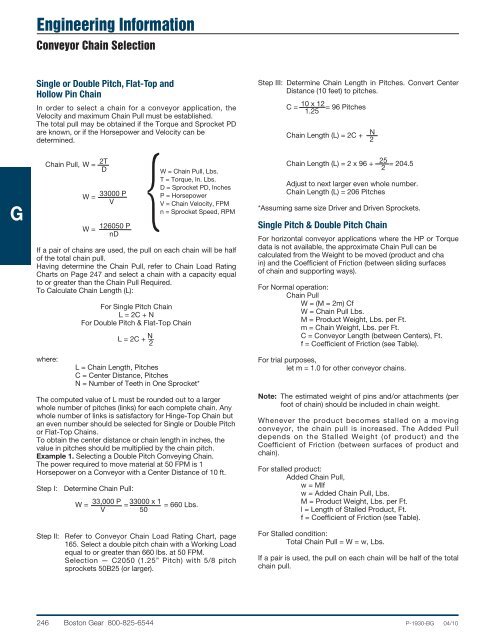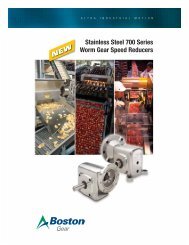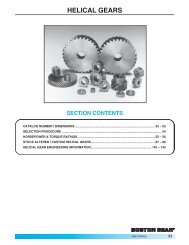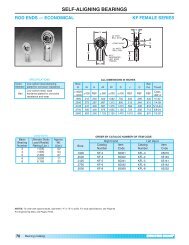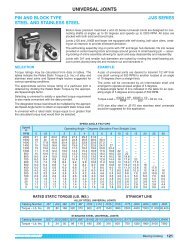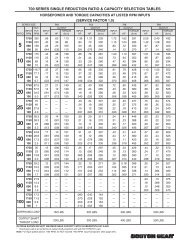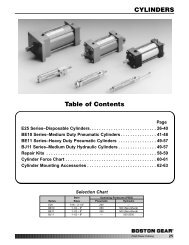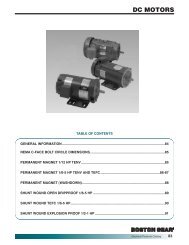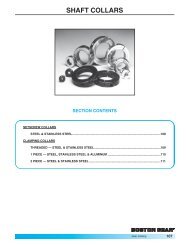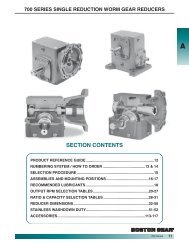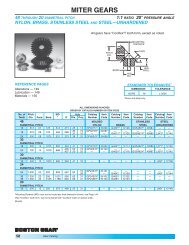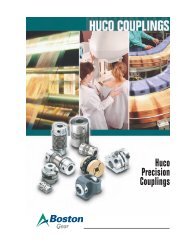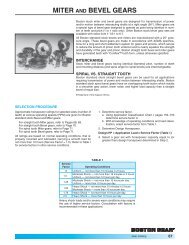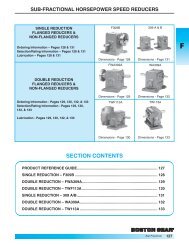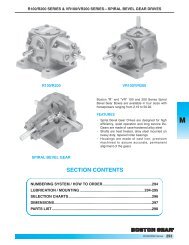Modified Stock Gearing - Boston Gear
Modified Stock Gearing - Boston Gear
Modified Stock Gearing - Boston Gear
You also want an ePaper? Increase the reach of your titles
YUMPU automatically turns print PDFs into web optimized ePapers that Google loves.
Engineering Information<br />
Conveyor Chain Selection<br />
G<br />
Single or Double Pitch, Flat-Top and<br />
Hollow Pin Chain<br />
In order to select a chain for a conveyor application, the<br />
Velocity and maximum Chain Pull must be established.<br />
The total pull may be obtained if the Torque and Sprocket PD<br />
are known, or if the Horsepower and Velocity can be<br />
determined.<br />
2T<br />
Chain Pull, W = D<br />
33000 P<br />
W =<br />
V<br />
W =<br />
126050 P<br />
nD<br />
If a pair of chains are used, the pull on each chain will be half<br />
of the total chain pull.<br />
Having determine the Chain Pull, refer to Chain Load Rating<br />
Charts on Page 247 and select a chain with a capacity equal<br />
to or greater than the Chain Pull Required.<br />
To Calculate Chain Length (L):<br />
where:<br />
For Single Pitch Chain<br />
L = 2C + N<br />
For Double Pitch & Flat-Top Chain<br />
L = 2C +<br />
N<br />
— 2<br />
L = Chain Length, Pitches<br />
C = Center Distance, Pitches<br />
N = Number of Teeth in One Sprocket*<br />
The computed value of L must be rounded out to a larger<br />
whole number of pitches (links) for each complete chain. Any<br />
whole number of links is satisfactory for Hinge-Top Chain but<br />
an even number should be selected for Single or Double Pitch<br />
or Flat-Top Chains.<br />
To obtain the center distance or chain length in inches, the<br />
value in pitches should be multiplied by the chain pitch.<br />
Example 1. Selecting a Double Pitch Conveying Chain.<br />
The power required to move material at 50 FPM is 1<br />
Horsepower on a Conveyor with a Center Distance of 10 ft.<br />
Step I:<br />
W = Chain Pull, Lbs.<br />
T = Torque, In. Lbs.<br />
D = Sprocket PD, Inches<br />
P = Horsepower<br />
V = Chain Velocity, FPM<br />
{n = Sprocket Speed, RPM<br />
Determine Chain Pull:<br />
W =<br />
33,000 P<br />
=<br />
33000 x 1<br />
= 660 Lbs.<br />
V 50<br />
Step III: Determine Chain Length in Pitches. Convert Center<br />
Distance (10 feet) to pitches.<br />
C =<br />
10 x 12<br />
= 96 Pitches<br />
1.25<br />
Chain Length (L) = 2C +<br />
N<br />
2<br />
25<br />
Chain Length (L) = 2 x 96 + = 204.5<br />
2<br />
Adjust to next larger even whole number.<br />
Chain Length (L) = 206 Pitches<br />
*Assuming same size Driver and Driven Sprockets.<br />
Single Pitch & Double Pitch Chain<br />
For horizontal conveyor applications where the HP or Torque<br />
data is not available, the approximate Chain Pull can be<br />
calculated from the Weight to be moved (product and cha<br />
in) and the Coefficient of Friction (between sliding surfaces<br />
of chain and supporting ways).<br />
For Normal operation:<br />
Chain Pull<br />
W = (M = 2m) Cf<br />
W = Chain Pull Lbs.<br />
M = Product Weight, Lbs. per Ft.<br />
m = Chain Weight, Lbs. per Ft.<br />
C = Conveyor Length (between Centers), Ft.<br />
f = Coefficient of Friction (see Table).<br />
For trial purposes,<br />
let m = 1.0 for other conveyor chains.<br />
Note: The estimated weight of pins and/or attachments (per<br />
foot of chain) should be included in chain weight.<br />
Whenever the product becomes stalled on a moving<br />
conveyor, the chain pull is increased. The Added Pull<br />
depends on the Stalled Weight (of product) and the<br />
Coefficient of Friction (between surfaces of product and<br />
chain).<br />
For stalled product:<br />
Added Chain Pull,<br />
w = Mlf<br />
w = Added Chain Pull, Lbs.<br />
M = Product Weight, Lbs. per Ft.<br />
l = Length of Stalled Product, Ft.<br />
f = Coefficient of Friction (see Table).<br />
Step II:<br />
Refer to Conveyor Chain Load Rating Chart, page<br />
165. Select a double pitch chain with a Working Load<br />
equal to or greater than 660 lbs. at 50 FPM.<br />
Selection — C2050 (1.25” Pitch) with 5/8 pitch<br />
sprockets 50B25 (or larger).<br />
For Stalled condition:<br />
Total Chain Pull = W = w, Lbs.<br />
If a pair is used, the pull on each chain will be half of the total<br />
chain pull.<br />
246 <strong>Boston</strong> <strong>Gear</strong> 800-825-6544 P-1930-BG 04/10


